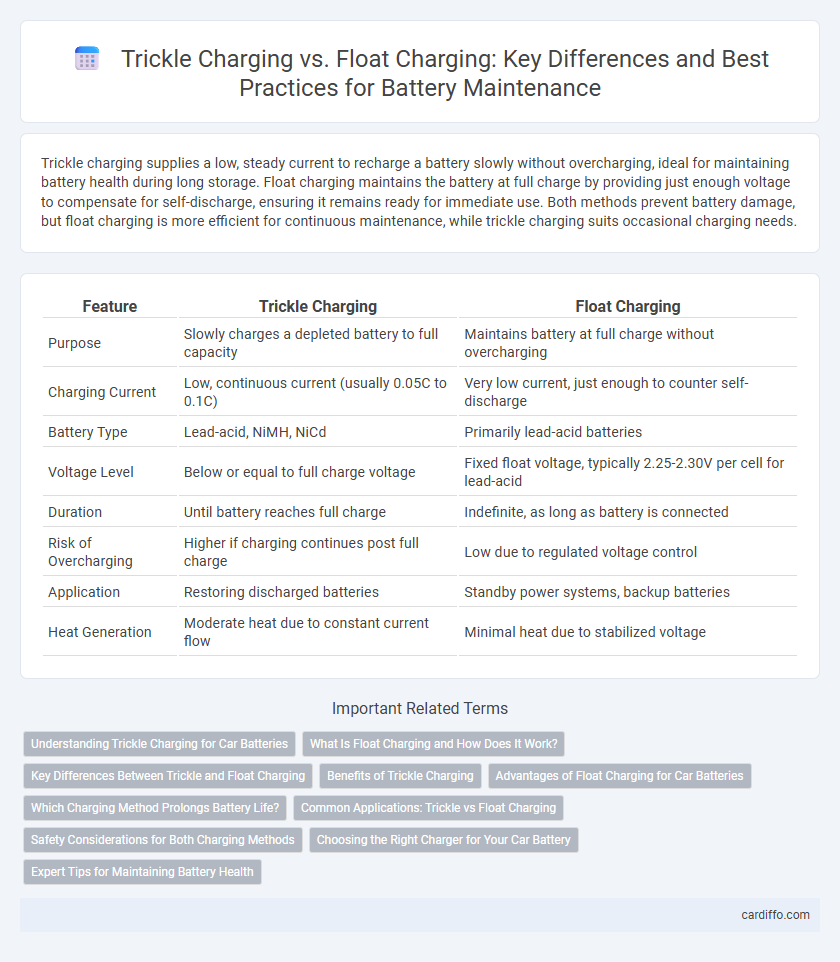Trickle charging supplies a low, steady current to recharge a battery slowly without overcharging, ideal for maintaining battery health during long storage. Float charging maintains the battery at full charge by providing just enough voltage to compensate for self-discharge, ensuring it remains ready for immediate use. Both methods prevent battery damage, but float charging is more efficient for continuous maintenance, while trickle charging suits occasional charging needs.
Table of Comparison
| Feature | Trickle Charging | Float Charging |
|---|---|---|
| Purpose | Slowly charges a depleted battery to full capacity | Maintains battery at full charge without overcharging |
| Charging Current | Low, continuous current (usually 0.05C to 0.1C) | Very low current, just enough to counter self-discharge |
| Battery Type | Lead-acid, NiMH, NiCd | Primarily lead-acid batteries |
| Voltage Level | Below or equal to full charge voltage | Fixed float voltage, typically 2.25-2.30V per cell for lead-acid |
| Duration | Until battery reaches full charge | Indefinite, as long as battery is connected |
| Risk of Overcharging | Higher if charging continues post full charge | Low due to regulated voltage control |
| Application | Restoring discharged batteries | Standby power systems, backup batteries |
| Heat Generation | Moderate heat due to constant current flow | Minimal heat due to stabilized voltage |
Understanding Trickle Charging for Car Batteries
Trickle charging maintains a car battery's charge by delivering a low, steady current to prevent overcharging while compensating for self-discharge. This method is ideal for long-term battery maintenance, ensuring optimal battery life and performance during extended periods of inactivity. Understanding trickle charging helps avoid issues like sulfation and prolongs the overall health of lead-acid car batteries.
What Is Float Charging and How Does It Work?
Float charging maintains a battery at full charge by supplying a constant, low voltage that compensates for self-discharge, preventing overcharging and extending battery life. This technique uses a regulated power source to provide just enough current to offset energy loss without causing heat buildup or damage. Commonly applied in standby power systems and emergency backup batteries, float charging ensures readiness without compromising battery health.
Key Differences Between Trickle and Float Charging
Trickle charging delivers a low, continuous current to maintain a battery's charge without overcharging, ideal for long-term storage and low self-discharge batteries. Float charging maintains the battery at full charge by applying a constant voltage, compensating for self-discharge while preventing electrolyte depletion. The key difference lies in current control: trickle charging supplies a fixed low current, whereas float charging uses a regulated voltage to keep the battery fully charged.
Benefits of Trickle Charging
Trickle charging provides a controlled low current that safely maintains battery charge and prevents overcharging, extending battery life by reducing stress on battery cells. This method is particularly beneficial for batteries in long-term standby applications, ensuring they remain fully charged without degradation. Trickle charging enhances battery reliability and readiness by compensating for self-discharge while preserving optimal capacity.
Advantages of Float Charging for Car Batteries
Float charging maintains car batteries at a steady voltage, preventing overcharging and extending battery lifespan compared to trickle charging. It provides a consistent, low current that compensates for self-discharge, optimizing battery health and readiness. This method reduces the risk of overheating and electrolyte loss, making it ideal for long-term battery maintenance in vehicles.
Which Charging Method Prolongs Battery Life?
Trickle charging provides a low, steady current to batteries, preventing deep discharge without overcharging, while float charging maintains the battery at full charge by supplying a minimal voltage to counter self-discharge. Float charging is generally more effective for prolonging battery life in standby applications because it avoids the continuous current flow associated with trickle charging, which can cause electrolyte loss and overheating. Choosing float charging extends the cycle life and overall performance of lead-acid and lithium-ion batteries by minimizing degradation.
Common Applications: Trickle vs Float Charging
Trickle charging is commonly used for small, sealed lead-acid batteries in devices like emergency lights and motorcycles to maintain charge without overcharging. Float charging is ideal for backup power systems such as uninterruptible power supplies (UPS) and solar energy storage, where a constant voltage charge keeps batteries fully charged over long periods. Both methods prevent battery sulfation but differ in application based on battery type and usage duration.
Safety Considerations for Both Charging Methods
Trickle charging delivers a low, continuous current to maintain a battery's charge without overcharging, minimizing risks of overheating and gas emission, which enhances safety during prolonged use. Float charging maintains a battery at full charge by supplying a constant voltage with a minimal current, ensuring the battery remains fully charged without damage, significantly reducing the risk of corrosion and thermal runaway. Proper monitoring and adherence to recommended voltage and current specifications for both methods are critical to preventing battery degradation and safety hazards like leakage or explosion.
Choosing the Right Charger for Your Car Battery
Trickle charging delivers a low, steady current to slowly charge a car battery without overcharging, ideal for prolonged maintenance or storage periods. Float charging maintains a battery at full charge by supplying a constant voltage, preventing self-discharge and ensuring readiness without battery damage. Selecting the right charger depends on the battery type and usage patterns, with trickle chargers suited for long-term storage and float chargers for continuous maintenance in vehicles used less frequently.
Expert Tips for Maintaining Battery Health
Trickle charging delivers a low, steady current to keep a battery fully charged without overcharging, ideal for long-term storage of lead-acid batteries. Float charging maintains a battery at full charge by providing a continuous, lower voltage that compensates for self-discharge, commonly used in standby power applications. Experts recommend monitoring voltage regularly and avoiding excessive trickle charging duration to prevent battery degradation and sulfation.
Trickle Charging vs Float Charging Infographic

 cardiffo.com
cardiffo.com